The Evolution of Artificial Intelligence in the Digital Economy: An Application of the Potential Dirichlet Allocation Model
Abstract
:1. Introduction
2. Research Background
3. Research Methodology and Data Processing
3.1. Workshop Air Conditioning System Model
3.1.1. Strength Evolution of Technical Topics
3.1.2. Evolution of Technical Subject Content
3.2. Workshop Air Conditioning System Model
3.2.1. Data Collection
3.2.2. Data Preprocessing
4. Results and Discussion
4.1. LDA Theme Mining
4.1.1. Super Parameter Setting
4.1.2. Determination of the Number of Topics
4.2. Parameter Settings
4.3. Evolution Analysis of Artificial Intelligence Technology
4.3.1. Artificial Intelligence Technology Strength Evolution
4.3.2. Artificial Intelligence Technology Content Evolution
5. Conclusions and Recommendations
5.1. Conclusions
5.2. Recommendations
5.2.1. Promoting the Integration of Artificial Intelligence and Industry to Digitize Industry
5.2.2. Building an AI + loT Ecosystem and Focusing on the Industrialization of Digital Technologies
5.2.3. Strengthen Core Innovation Capabilities
Author Contributions
Funding
Institutional Review Board Statement
Informed Consent Statement
Data Availability Statement
Conflicts of Interest
References
- Zhang, C.; Lu, Y. Study on artificial intelligence: The state of the art and future prospects. J. Ind. Inf. Integr. 2021, 23, 100224. [Google Scholar] [CrossRef]
- Jha, K.; Doshi, A.; Patel, P.; Shah, M. A comprehensive review on automation in agriculture using artificial intelligence. Artif. Intell. Agric. 2019, 2, 1–12. [Google Scholar] [CrossRef]
- Dharmaraj, V.; Vijayanand, C. Artificial intelligence (AI) in agriculture. Int. J. Curr. Microbiol. Appl. Sci. 2018, 7, 2122–2128. [Google Scholar] [CrossRef]
- Li, K.Q.; Liu, Y.; Kang, Q. Estimating the thermal conductivity of soils using six machine learning algorithms. Int. Commun. Heat Mass Transf. 2022, 136, 106139. [Google Scholar] [CrossRef]
- Li, K.Q.; Kang, Q.; Nie, J.Y.; Huang, X.W. Artificial neural network for predicting the thermal conductivity of soils based on a systematic database. Geothermics 2022, 103, 102416. [Google Scholar] [CrossRef]
- Tabbussum, R.; Dar, A.Q. Performance evaluation of artificial intelligence paradigms—Artificial neural networks, fuzzy logic, and adaptive neuro-fuzzy inference system for flood prediction. Environ. Sci. Pollut. Res. 2021, 28, 25265–25282. [Google Scholar] [CrossRef]
- Crosby, M. Patents, innovation and growth. Econ. Rec. 2000, 76, 255–262. [Google Scholar] [CrossRef]
- Karvonen, M.; Kässi, T. Patent citations as a tool for analysing the early stages of convergence. Technol. Forecast. Soc. Change 2013, 80, 1094–1107. [Google Scholar] [CrossRef]
- Urbaniec, M.; Tomala, J.; Martinez, S. Measurements and Trends in Technological Eco-Innovation: Evidence from Environment-Related Patents. Resources 2021, 10, 68. [Google Scholar] [CrossRef]
- Miao, Z.; Du, J.; Dong, F.; Liu, Y.; Wang, X. Identifying technology evolution pathways using topic variation detection based on patent data: A case study of 3D printing. Futures 2020, 118, 102530. [Google Scholar] [CrossRef]
- Chen, M.C.; Ho, P.H. Exploring technology opportunities and evolution of IoT-related logistics services with text mining. Complex Intell. Syst. 2021, 7, 2577–2595. [Google Scholar] [CrossRef]
- Chauhan, U.; Shah, A. Topic modeling using latent Dirichlet allocation: A survey. ACM Comput. Surv. (CSUR) 2021, 54, 1–35. [Google Scholar] [CrossRef]
- Zhang, H.; Daim, T.; Zhang, Y.P. Integrating patent analysis into technology roadmapping: A latent dirichlet allocation based technology assessment and roadmapping in the field of Blockchain. Technol. Forecast. Soc. Chang. 2021, 167, 120729. [Google Scholar] [CrossRef]
- Minsky, M. Steps toward artificial intelligence. Proc. IRE 1961, 49, 8–30. [Google Scholar] [CrossRef]
- Pollack, M.E. Artificial Intelligence—A Modern Approach—A Review. Ai Mag. 1995, 16, 73. [Google Scholar] [CrossRef]
- LeCun, Y.; Bengio, Y.; Hinton, G. Deep learning. Nature 2015, 521, 436–444. [Google Scholar] [CrossRef]
- Guzman, A.L.; Lewis, S.C. Artificial intelligence and communication: A Human–Machine Communication research agenda. New Media Soc. 2020, 22, 70–86. [Google Scholar] [CrossRef]
- Guo, K.; Yang, Z.; Yu, C.H.; Buehler, M.J. Artificial intelligence and machine learning in design of mechanical materials. Mater. Horiz. 2021, 8, 1153–1172. [Google Scholar] [CrossRef]
- Pareek, P.; Thakkar, A. A survey on video-based human action recognition: Recent updates, datasets, challenges, and applications. Artif. Intell. Rev. 2021, 54, 2259–2322. [Google Scholar] [CrossRef]
- Giczy, A.V.; Pairolero, N.A.; Toole, A.A. Identifying artificial intelligence (AI) invention: A novel AI patent dataset. J. Technol. Transf. 2022, 47, 476–505. [Google Scholar] [CrossRef]
- Roberts, H.; Cowls, J.; Morley, J.; Taddeo, M.; Wang, V.; Floridi, L. The Chinese approach to artificial intelligence: An analysis of policy, ethics, and regulation. AI Soc. 2021, 36, 59–77. [Google Scholar] [CrossRef]
- Xiang, X.; Li, Q.; Khan, S.; Khalaf, O.I. Urban water resource management for sustainable environment planning using artificial intelligence techniques. Environ. Impact Assess. Rev. 2021, 86, 106515. [Google Scholar] [CrossRef]
- Gao, F.; Jia, X.; Zhao, Z.; Chen, C.C.; Xu, F.; Geng, Z.; Song, X. Bibliometric analysis on tendency and topics of artificial intelligence over last decade. Microsyst. Technol. 2021, 27, 1545–1557. [Google Scholar] [CrossRef]
- Lundvall, B.Å.; Rikap, C. China’s catching-up in artificial intelligence seen as a co-evolution of corporate and national innovation systems. Res. Policy 2022, 51, 104395. [Google Scholar] [CrossRef]
- Huang, M.; Yubao, L.I. Research Progress and Prospect of Artificial Intelligence Education in China: Statistical Analysis Based on CNKI Journal Literature. Cross-Cult. Commun. 2020, 16, 44–53. [Google Scholar] [CrossRef]
- Liu, K.; Hu, X.G.; Ma, Y.H.; Na, D.; Zhang, Y.H. Outline of Artificial Intelligence Research in China’s Educational Field—Based on the Perspective of General Artificial Intelligence. Open Educ. Res. 2018, 24, 31–40. [Google Scholar] [CrossRef]
- Choi, H.; Woo, J.R. Investigating emerging hydrogen technology topics and comparing national level technological focus: Patent analysis using a structural topic model. Appl. Energy 2022, 313, 118898. [Google Scholar] [CrossRef]
- Li, X.D.; Zhang, J.; Yuan, M. Research on Topic Evolution of Sci-tech Journals Based on LDA Model. J. Inf. 2014, 7, 115–121. [Google Scholar] [CrossRef]
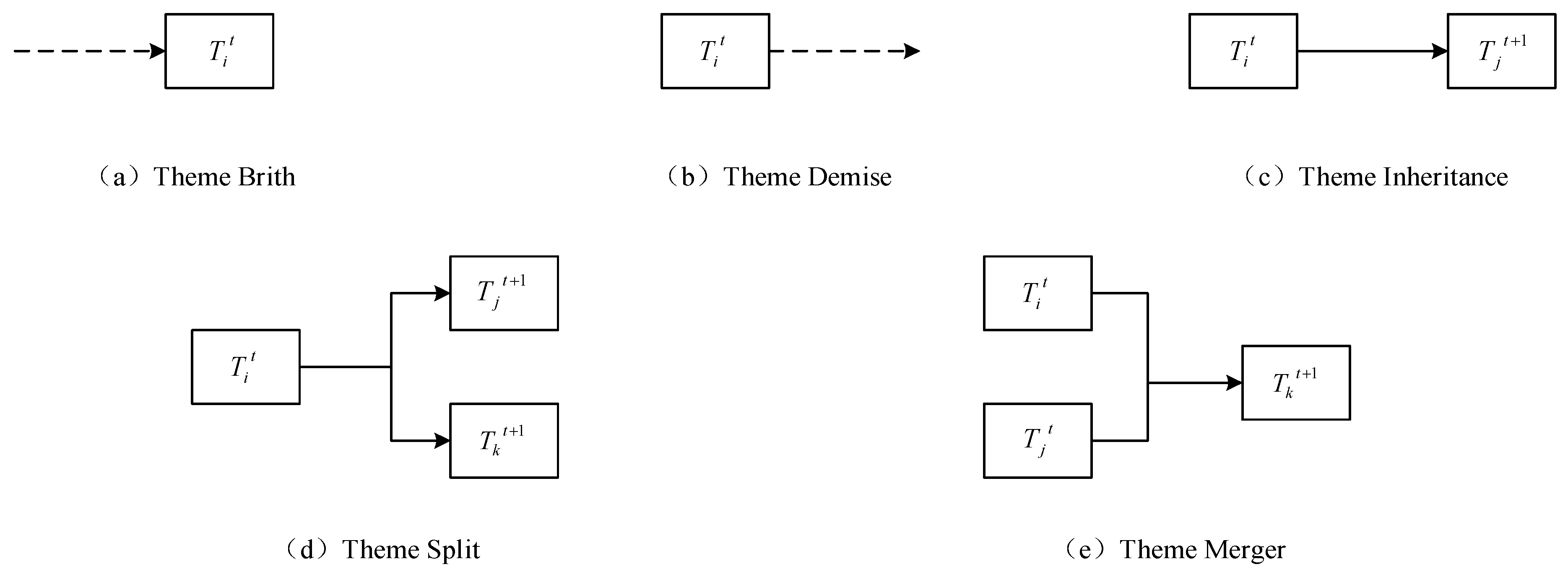
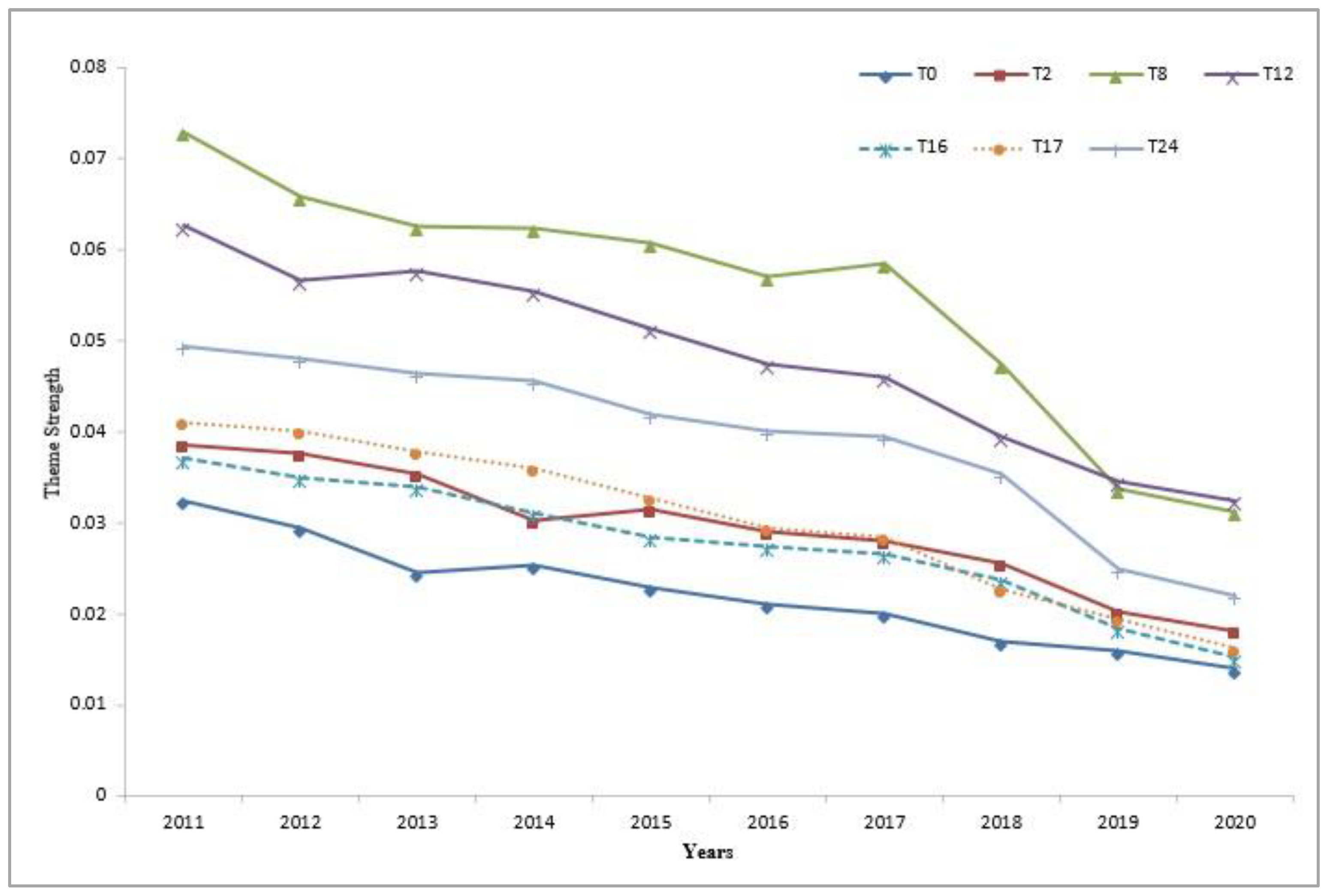
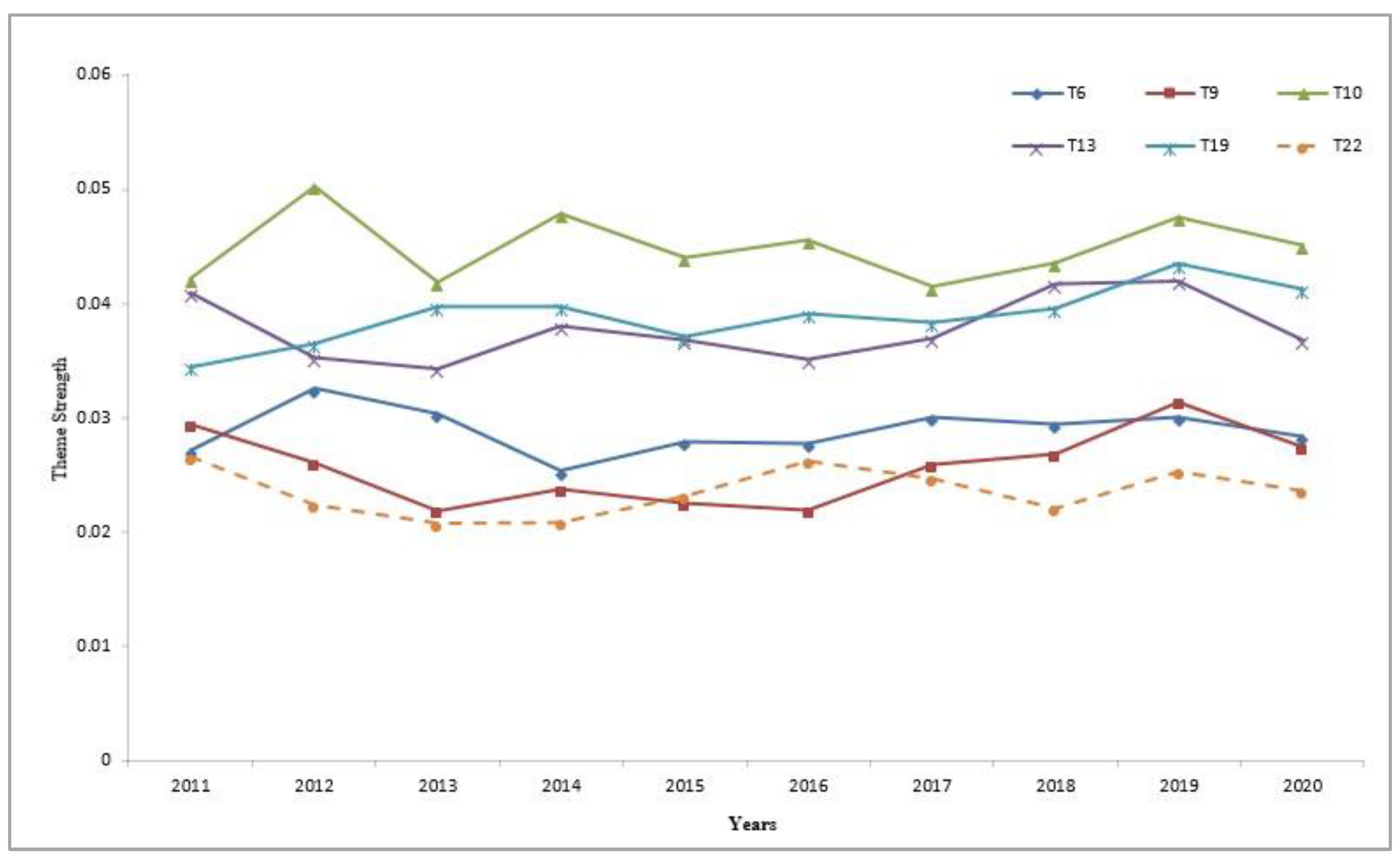
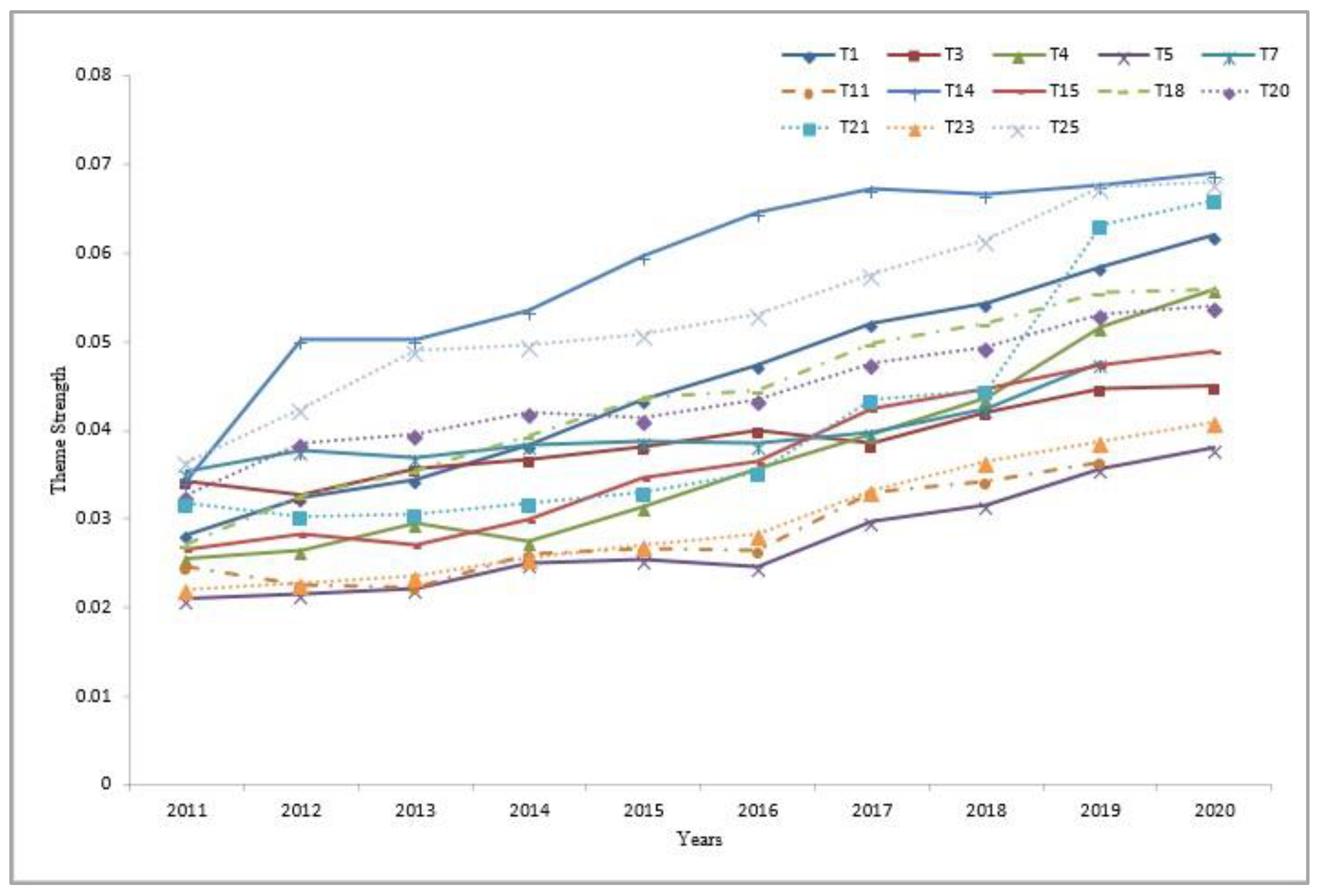
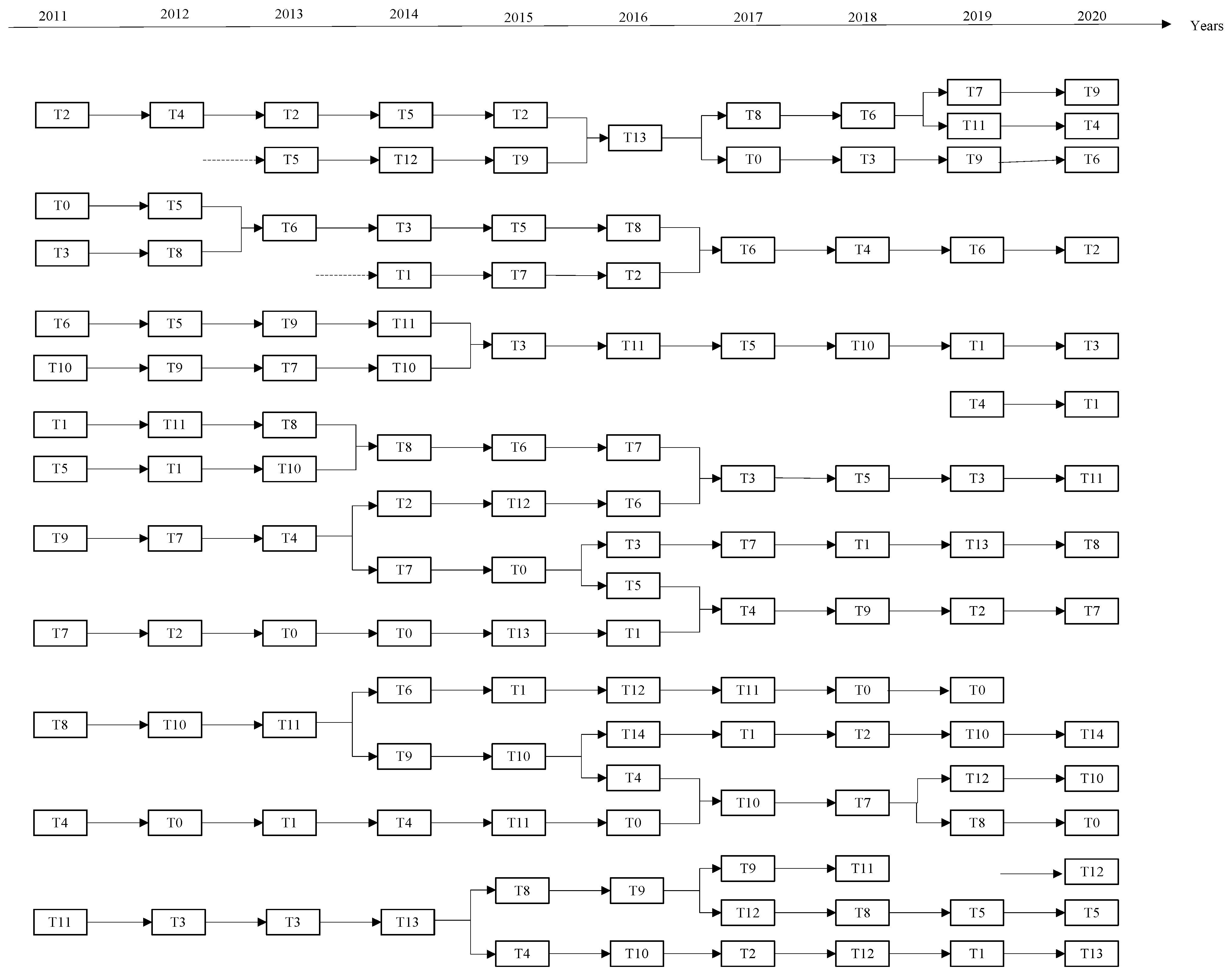
| Years | Number of Patents |
|---|---|
| 2011 | 562 |
| 2012 | 715 |
| 2013 | 904 |
| 2014 | 1271 |
| 2015 | 1464 |
| 2016 | 2335 |
| 2017 | 3004 |
| 2018 | 5102 |
| 2019 | 8473 |
| 2020 | 12,836 |
| Years | Number of Documents | Number of Words before Data Cleaning | Number of Words after Data Cleaning |
|---|---|---|---|
| 2011 | 562 | 399,935 | 74,223 |
| 2012 | 715 | 394,564 | 94,030 |
| 2013 | 904 | 467,460 | 122,431 |
| 2014 | 1271 | 717,601 | 176,621 |
| 2015 | 1464 | 707,403 | 190,808 |
| 2016 | 2335 | 1,022,635 | 306,261 |
| 2017 | 3004 | 1,213,419 | 396,898 |
| 2018 | 5102 | 1,808,530 | 719,666 |
| 2019 | 8473 | 2,389,493 | 838,059 |
| 2020 | 12,836 | 3,048,579 | 940,370 |
| Years | Optimal Number of Topics |
|---|---|
| 2011 | 11 |
| 2012 | 12 |
| 2013 | 12 |
| 2014 | 12 |
| 2015 | 14 |
| 2016 | 14 |
| 2017 | 15 |
| 2018 | 13 |
| 2019 | 13 |
| 2020 | 14 |
| Total text set | 26 |
| Years | Topic Mining Results |
|---|---|
| 2011 | Topic 0: Sensor, Topic 1: Process Execution, Topic 2: Alarm System, Topic 3: Speech Recognition, Topic 4: Cloud, Topic 5: User Services, Topic 6: Control System, Topic 7: Circuit and Signal, Topic 8: Image Recognition, Topic 9: Text Recognition, Topic 10: Data Analysis |
| 2012 | Topic 0: Process Execution, Topic 1: Vehicle Detection, Topic 2: Sensors, Topic 3: Data Analysis, Topic 4: Text Recognition, Topic 5: Control Systems, Topic 6: Alarm Systems, Topic 7: Speech Recognition, Topic 8: Cloud, Topic 9: Image Recognition Topic 10: Circuits and Signals, Topic 11: User Services |
| 2013 | Topic 0: Text Recognition, Topic 1: Control Systems, Topic 2: Speech Recognition, Topic 3: User Services, Topic 4: Sensors, Topic 5: Process Execution, Topic 5: Alarm Systems, Topic 7: Image Recognition, Topic 8: Data Processing, Topic 9: Circuits and Signals Topic 10: Cloud, Topic 11: Vehicle Detection |
| 2014 | Topic 0: Speech Recognition, Topic 1: Text Recognition, Topic 2: Motion Detection Devices, Topic 3: User Services, Topic 4: Image Recognition, Topic 5: Device Components, Topic 6: Machine Learning, Topic 7: Digital Signals, Topic 8: Vehicle Detection, Topic 9: Alarm Systems, Topic 10: Control Systems, Topic 11: Cloud |
| 2015 | Topic 0: Natural Language Processing, Topic 1: Neural Networks, Topic 2: Computer Vision, Topic 3: Machine Learning, Topic 4: Text Recognition, Topic 5: Motion Detection Devices, Topic 6: Cloud Intelligence, Topic 7: Video Recognition, Topic 8: Intelligent Transportation, Topic 9. Intelligent Computing, Topic 10: Digital Signals, Topic 11: Alarm Systems, Topic 12: Device Components, Topic 13: User Services |
| 2016 | Topic 0: Video Recognition, Topic 1: Cloud Intelligence, Topic 2: Motion Detection Devices, Topic 3: Smart Security, Topic 4: Smart Robotics, Topic 5: Machine Learning, Topic 6: Smart Transportation, Topic 7: Neural Networks, Topic 8: User Services, Topic 9: Device Components, Topic 10: Intelligent Computing, Topic 11: Text Recognition, Topic 12: Computer Vision, Topic 13: Natural Language Processing |
| 2017 | Topic 0: Text Recognition, Topic 1: Natural Language Processing, Topic 2: Neural Networks, Topic 3: Intelligent Healthcare, Topic 4: Intelligent Computing, Topic 5: Video Recognition, Topic 6: Computer Vision, Topic 7: Intelligent Transportation, Topic 8: Machine Learning, Topic 9: User Services, Topic 10: Smart Robotics, Topic 11: Smart Security, Topic 12: Cloud Intelligence, Topic 13: Mobile Terminal, Topic 14: Smart Finance |
| 2018 | Topic 0: Wearable Devices, Topic 1: Smart Finance, Topic 2: Smart Robotics, Topic 3: Smart Driving, Topic 4: Smart Education, Topic 5: Smart Security, Topic 6: Deep Learning, Topic 7: Smart Healthcare, Topic 8: Mobile Terminals, Topic 9: Human–Computer Interaction, Topic 10: Smart Search, Topic 11: Cloud Intelligence, Topic 12: User Services |
| 2019 | Topic 0: Smart Work, Topic 1: Smart Healthcare, Topic 2: Smart Finance, Topic 3: Wearable Devices, Topic 4: Deep Learning, Topic 5: Smart Driving, Topic 6: Mobile Terminals, Topic 7: Smart Search, Topic 8: User Services, Topic 9: Smart Education Topic 10: Smart Security, Topic 11: Human–Computer Interaction, Topic 12: Smart Robotics |
| 2020 | Topic 0: AI chips, Topic 1: Machine Learning, Topic 2: Smart Driving, Topic 3: Deep Learning, Topic 4: Smart Healthcare, Topic 5: Industrial Internet, Topic 6: Big Data Prediction, Topic 7: Cloud Platforms, Topic 8: Video Recognition, Topic 9: Speech Recognition Topic 10: Mobile terminals, Topic 11: User services, Topic 12: Human–Computer interaction, Topic 13: Image recognition |
| Total text set | Topic 0: Circuit and Signal, Topic 1: Smart Medical, Topic 2: Sensor, Topic 3: Intelligent Computing, Topic 4: Cloud Intelligence, Topic 5: Computer Vision, Topic 6: Neural Network, Topic 7: Intelligent Robot, Topic 8: Process Execution, Topic 9: Digital Signal Processing, Topic 10: User Services, Topic 11: Natural Language Processing, Topic 12: Data Analysis, Topic 13: Motion Detection Equipment, Topic 14: Deep Learning, Topic 15: Smart Driving, Topic 16: Image Recognition, Topic 17: Speech Recognition, Topic 18: Text Recognition, Topic 19: Mobile Terminal, Topic 20: Smart Security, Topic 21: Video Recognition, Topic 22: Control System, Topic 23: Human–Computer Interaction, Topic 24: Equipment Components, Topic 25: Smart Education |
| T0 | T1 | T2 | T3 | T4 | T5 | T6 | T7 | T8 | T9 | T10 | |
| T0 | 0.31 | 0.88 | 0.29 | 0.54 | 0.54 | 0.53 | 0.32 | 0.37 | 0.53 | 0.49 | 0.15 |
| T1 | 0.22 | 0.68 | 0.35 | 0.33 | 0.22 | 0.44 | 0.69 | 0.83 | 0.77 | 0.48 | 0.19 |
| T2 | 0.86 | 0.52 | 0.64 | 0.32 | 0.47 | 0.42 | 0.31 | 0.72 | 0.69 | 0.77 | 0.60 |
| T3 | 0.39 | 0.45 | 0.79 | 0.85 | 0.63 | 0.33 | 0.41 | 0.68 | 0.33 | 0.43 | 0.87 |
| T4 | 0.29 | 0.32 | 0.67 | 0.16 | 0.73 | 0.61 | 0.67 | 0.25 | 0.34 | 0.85 | 0.24 |
| T5 | 0.36 | 0.38 | 0.32 | 0.72 | 0.22 | 0.73 | 0.82 | 0.72 | 0.65 | 0.55 | 0.19 |
| T6 | 0.68 | 0.17 | 0.88 | 0.31 | 0.82 | 0.24 | 0.4 | 0.45 | 0.61 | 0.33 | 0.73 |
| T7 | 0.24 | 0.54 | 0.74 | 0.88 | 0.31 | 0.84 | 0.29 | 0.21 | 0.67 | 0.80 | 0.75 |
| T8 | 0.53 | 0.53 | 0.26 | 0.40 | 0.91 | 0.63 | 0.61 | 0.26 | 0.29 | 0.39 | 0.64 |
| T9 | 0.79 | 0.31 | 0.51 | 0.61 | 0.67 | 0.83 | 0.33 | 0.64 | 0.80 | 0.20 | 0.63 |
| T10 | 0.82 | 0.68 | 0.39 | 0.82 | 0.76 | 0.26 | 0.44 | 0.87 | 0.59 | 0.75 | 0.35 |
| T11 | 0.31 | 0.68 | 0.29 | 0.54 | 0.54 | 0.93 | 0.32 | 0.37 | 0.53 | 0.49 | 0.15 |
Disclaimer/Publisher’s Note: The statements, opinions and data contained in all publications are solely those of the individual author(s) and contributor(s) and not of MDPI and/or the editor(s). MDPI and/or the editor(s) disclaim responsibility for any injury to people or property resulting from any ideas, methods, instructions or products referred to in the content. |
© 2023 by the authors. Licensee MDPI, Basel, Switzerland. This article is an open access article distributed under the terms and conditions of the Creative Commons Attribution (CC BY) license (https://creativecommons.org/licenses/by/4.0/).
Share and Cite
Shan, C.; Wang, J.; Zhu, Y. The Evolution of Artificial Intelligence in the Digital Economy: An Application of the Potential Dirichlet Allocation Model. Sustainability 2023, 15, 1360. https://doi.org/10.3390/su15021360
Shan C, Wang J, Zhu Y. The Evolution of Artificial Intelligence in the Digital Economy: An Application of the Potential Dirichlet Allocation Model. Sustainability. 2023; 15(2):1360. https://doi.org/10.3390/su15021360
Chicago/Turabian StyleShan, Chunyi, Jun Wang, and Yongming Zhu. 2023. "The Evolution of Artificial Intelligence in the Digital Economy: An Application of the Potential Dirichlet Allocation Model" Sustainability 15, no. 2: 1360. https://doi.org/10.3390/su15021360
APA StyleShan, C., Wang, J., & Zhu, Y. (2023). The Evolution of Artificial Intelligence in the Digital Economy: An Application of the Potential Dirichlet Allocation Model. Sustainability, 15(2), 1360. https://doi.org/10.3390/su15021360


_Li.png)


